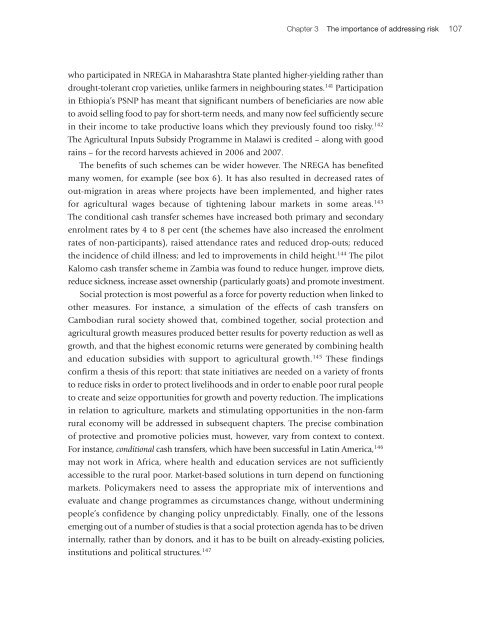English - IFAD
English - IFAD
English - IFAD
Create successful ePaper yourself
Turn your PDF publications into a flip-book with our unique Google optimized e-Paper software.
Chapter 3 The importance of addressing risk 107<br />
who participated in NREGA in Maharashtra State planted higher-yielding rather than<br />
drought-tolerant crop varieties, unlike farmers in neighbouring states. 141 Participation<br />
in Ethiopia’s PSNP has meant that significant numbers of beneficiaries are now able<br />
to avoid selling food to pay for short-term needs, and many now feel sufficiently secure<br />
in their income to take productive loans which they previously found too risky. 142<br />
The Agricultural Inputs Subsidy Programme in Malawi is credited – along with good<br />
rains – for the record harvests achieved in 2006 and 2007.<br />
The benefits of such schemes can be wider however. The NREGA has benefited<br />
many women, for example (see box 6). It has also resulted in decreased rates of<br />
out-migration in areas where projects have been implemented, and higher rates<br />
for agricultural wages because of tightening labour markets in some areas. 143<br />
The conditional cash transfer schemes have increased both primary and secondary<br />
enrolment rates by 4 to 8 per cent (the schemes have also increased the enrolment<br />
rates of non-participants), raised attendance rates and reduced drop-outs; reduced<br />
the incidence of child illness; and led to improvements in child height. 144 The pilot<br />
Kalomo cash transfer scheme in Zambia was found to reduce hunger, improve diets,<br />
reduce sickness, increase asset ownership (particularly goats) and promote investment.<br />
Social protection is most powerful as a force for poverty reduction when linked to<br />
other measures. For instance, a simulation of the effects of cash transfers on<br />
Cambodian rural society showed that, combined together, social protection and<br />
agricultural growth measures produced better results for poverty reduction as well as<br />
growth, and that the highest economic returns were generated by combining health<br />
and education subsidies with support to agricultural growth. 145 These findings<br />
confirm a thesis of this report: that state initiatives are needed on a variety of fronts<br />
to reduce risks in order to protect livelihoods and in order to enable poor rural people<br />
to create and seize opportunities for growth and poverty reduction. The implications<br />
in relation to agriculture, markets and stimulating opportunities in the non-farm<br />
rural economy will be addressed in subsequent chapters. The precise combination<br />
of protective and promotive policies must, however, vary from context to context.<br />
For instance, conditional cash transfers, which have been successful in Latin America, 146<br />
may not work in Africa, where health and education services are not sufficiently<br />
accessible to the rural poor. Market-based solutions in turn depend on functioning<br />
markets. Policymakers need to assess the appropriate mix of interventions and<br />
evaluate and change programmes as circumstances change, without undermining<br />
people’s confidence by changing policy unpredictably. Finally, one of the lessons<br />
emerging out of a number of studies is that a social protection agenda has to be driven<br />
internally, rather than by donors, and it has to be built on already-existing policies,<br />
institutions and political structures. 147

















